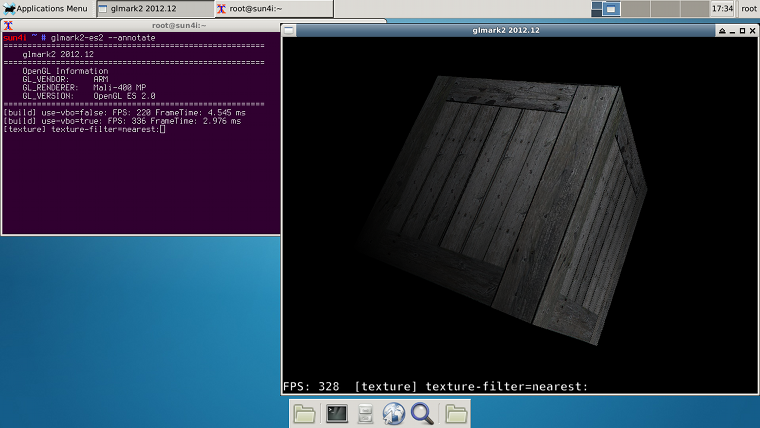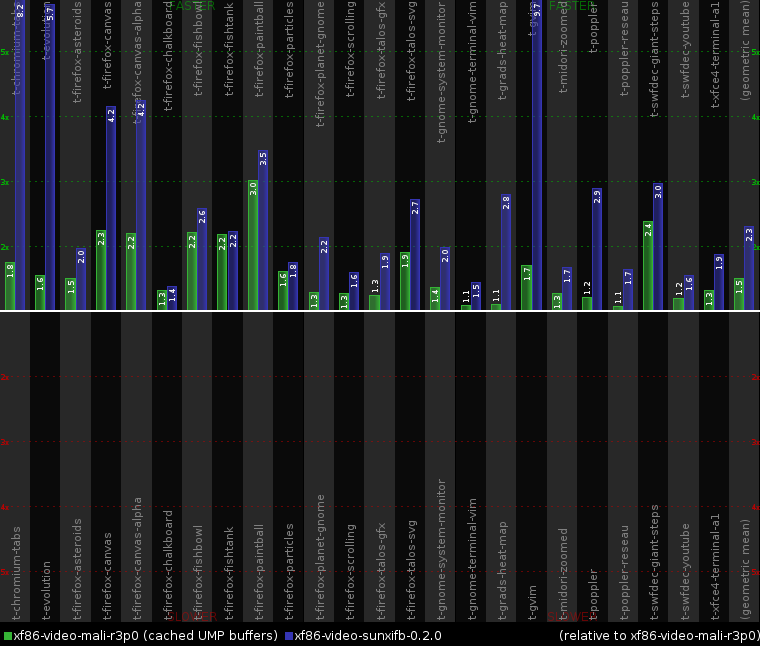New xf86-video-sunxifb DDX driver for Xorg
A short introduction
Allwinner A10/A13 SoC is very interesting because it is used in a lot of very affordable electronic devices from China, such as USB dongles, media boxes, tablets, netbooks and even the cubieboard.org development board. Because of a very competitive price, these devices make a good alternative for Raspberry Pi.
One rather unique and somewhat attractive feature is that this platform does not have a corporate backing and does not suffer from "too many cooks" problem :-) All the hardware adaptation support is provided by the community at http://linux-sunxi.org/, where the people are currently trying to clean up the kernel and fix numerous bugs.
3D graphics performance
Allwinner A10 uses a single-core Mali-400 GPU running at 320MHz, which provides OpenGL ES 2.0 acceleration. The OpenGL ES implementation itself relies on the proprietary closed source libMali.so library. But the integration with the X server is provided by the open source reference driver xf86-video-mali. Many users might assume that it's a ready-to-use complete solution and a natural choice for their devices. However this is not quite true. The performance of the system is also largely dependent on the optimal integration with the display controller hardware, because Mali itself can only render 3D images to memory buffers. Here is a quote from the readme file included with xf86-video-mali:
xf86-video-mali" is provided as a basis for creating your own X Display
Driver. It requires a recent version of the xorg-server, as well as a
successfull integration of UMP with your display device driver.As such, a more complete implementation of X11 driver is needed, and my attempt to develop one (based on xf86-video-fbdev) is available here: xf86-video-sunxifb. Below is the screenshot of it running on Mele A2000 TV box
The glmark2 2012.12 scores with 1280x720-32@60Hz monitor resolution look like this:
| X11 DDX driver | Fullscreen (1280x720) | Window (800x600) | Partially obscured window (800x600) |
|---|---|---|---|
| xf86-video-mali r3p0 | 38 | 65 | 66 |
| xf86-video-sunxifb-0.2.0 | 115 | 165 | 50 |
As expected from the implementation which is aware of the hardware overlays supported by the display controller, the performance of xf86-video-sunxifb in fullscreen mode or working with fully visible windows is significantly better than xf86-video-mali. Though rendering to partially obscured window currently goes through the fallback path involving many memory copy operations, and the overhead of these memory copy operations is even higher than for xf86-video-mali (mostly because of the use of the shadow framebuffer).
2D graphics performance
Now this is the most interesting part, because surprisingly 2D tends to be rather problematic for many drivers. Below is the chart based on the results from cairo-perf-trace running trimmed-cairo-traces.
Looks like xf86-video-sunxifb is implementing some great performance optimizations? I wish this was the case, but in fact it is basically just the functionality entirely provided by the original xf86-video-fbdev code, which was used as the base for xf86-video-sunxifb. It merely tries not to get in the way and just lets ARM NEON software rendering code from pixman run without too much extra overhead.
So what is wrong with the xf86-video-mali? Appears that it suffers from the same problem as many other X11 drivers for ARM hardware. DRI2 extension (the thing which is used for the integration of GLES acceleration) needs some hardware-specific buffers allocation (UMP in the case of xf86-video-mali). And EXA framework (a convenience layer for adding 2D acceleration hooks) supports overriding pixmap buffers allocation as part of its functionality. So the guys apparently decided that it's a good idea to override the allocation of absolutely all pixmaps without exception and not just the ones needed for DRI2. This was a total 2D performance disaster for the SGX PVR driver. And it is also killing 2D performance for xf86-video-mali. Because the sources of xf86-video-mali are available, it was possible to run one more somewhat artificial test. With a minor tweak, xf86-video-mali can be changed to do allocations of pixmaps in cached UMP buffers (let's for a moment just ignore the potential cache coherency issues for the buffers shared with Mali hardware via DRI2 and only look at the performance). The benchmark results for this modified xf86-video-mali driver are shown as green bars on the chart above. In some cases (t-firefox-fishtank), the performance for cached UMP allocations managed to catch up with xf86-video-sunxifb (and xf86-video-fbdev). But many other traces are still slow, which suggests that uncached memory allocation is not the only reason for poor performance. The UMP itself also requires expensive ioctls and has very heavy overhead. So sorry, the following suggestion from xf86-video-mali readme file is simply not going to fly:
The provided "xf86-video-mali" driver contains an EXA module which has been
integrated with the UMP system. Your 2D driver may therefore require an
integration with UMP as well. The suggestion is to pass the secure ID down to
the kernel device driver for your hardware, but it is also possible to get the
CPU-mapped address for the memory by calling ump_mapped_pointer_get.
Please refer to UMP documentation for more information regarding this.BTW, if anyone has some doubts and wonders if these colored bars in the chart are really correlated with reality, I suggest checking my youtube video about Linux on ARM Chromebook: xf86-video-armsoc vs. xf86-video-fbdev. The xf86-video-armsoc driver has all the same 2D performance problems :-(
It really puzzles me why nearly all the X11 drivers for ARM hardware are making the same mistake. An old X11 DDX driver from Nokia N900 at least could do separate allocation for DRI2 buffers and normal pixmaps, while being not the best and cleanest implementation for sure.
The future of xf86-video-sunxifb
XV and XRANDR still need to be implemented. And of course there is still a lot of room for real 2D performance improvements :-)
Edited within a few hours after posting to fix some obvious typos, broken links and poor wording


